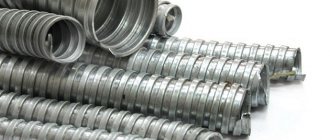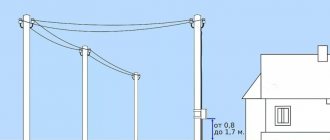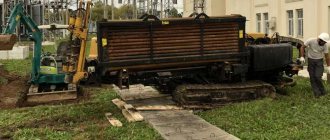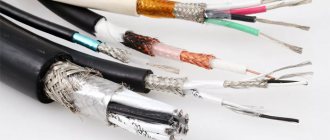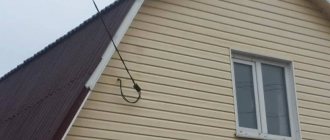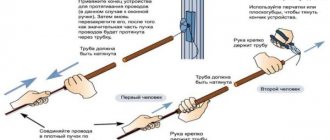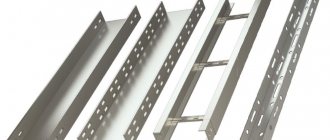Installation and laying of electrical wiring is accompanied by equally important additional processes, such as marking and installation of protection. The most effective product for increasing resistance to mechanical stress is a metal hose for cables.
This device fully meets the expectations of installers and is often used as the main protective element for electrical systems in wooden houses. The sleeve is easy to install and operate; wiring can be pulled through it without resorting to the use of special devices, and the risk of bending the cable inside it is minimized.
How does a metal hose work?
The invention of corrugated metal hoses is considered to be a revolutionary discovery, thanks to which the level of safety when laying cables has significantly increased, and additional options have appeared for organizing hidden wiring. Compared to conventional smooth-walled pipes, corrugated products have several undoubted advantages. These include high strength (reliability), flexibility and lower weight.
By placing the cable in the ground, depending on the depth of the trench, you place a serious mechanical load on it. It is known from the laws of physics that the larger the area, the less the pressure exerted on it. Smooth-walled structures are noticeably narrower than corrugated, which leads to a reduction in the load level per linear meter.
However, this approach has certain nuances. When laying a cable in the ground or screed, you must ensure that the earth or cement-sand mortar adheres as tightly as possible to the protective shell. Ignoring this rule can lead to increased deformation due to the presence of voids that disrupt the uniformity of load distribution.
How metal hoses are made
The production of corrugated metal hoses is divided into several stages. To begin, select a sheet of steel that can withstand the potential operating conditions. The thickness of the workpiece, which is subsequently rolled into a thin-walled pipe, varies between 0.2-0.3 mm. To connect a series of steel sheets, flat convex or concave washers with bolts are used.
Argon welding allows you to fix a cylindrical shape, while this process takes place on automatic lines that include laser systems. The latter are necessary for quality control of the welded joint (seam). The main condition is that the width of the seam should not exceed the thickness of the steel sheet. Next, the product is galvanized to improve its anti-corrosion properties. Stainless steel is better suited than others for the production of corrugated metal hoses, as it increases the tightness, reliability and resistance of the product to chemically active environments.
The segmented plane is formed under pressure from rollers, which are selected depending on the desired configuration and diameter of the pipe. In general, the final product has two diameters - minimum and maximum, which depend on the size of the segments. The narrowing of the diameter is insignificant and is achieved by reducing the wall thickness. This is due to the increased flexibility of the metal hose. This property eliminates the need to use fittings and other products to turn and avoid obstacles on the cable route.
Classification of metal hoses for laying electrical networks
Corrugated metal pipes, depending on their resistance to mechanical loads, are divided into three types:
- Lightweight with increased flexibility and low mechanical strength. Installation and operation of these products is possible if one important condition is met - there is no load on them. An excellent option for installation under false ceilings or sheets of plasterboard.
- Heavy with good mechanical strength. Such products are suitable for hidden installation in the ground, screed or under a layer of plaster.
- Extra heavy with maximum mechanical strength. These hoses should be used in conditions of increased safety requirements. For example, when laying communication lines in public places with a large flow of people (educational institutions, metro, hospitals).
The above example of corrugation classification is simplified, since the load-bearing range is very large and can reach 4000 N/cm2.
Depending on the shape of the internal section, pipes are divided into round and ellipsoidal. The latter are used in telecommunication tunnels.
Galvanized hoses can be equipped with various materials that increase the tightness of the products. The following varieties can be distinguished:
- ordinary corrugation - without seals, not airtight, flexible, retains high strength (withstands temperatures up to 300 degrees Celsius);
- with cotton seal;
- with a moisture-proof sleeve made of polyvinyl chloride - provides protection against moisture and leakage currents, but the ability to withstand high temperatures is halved.
Important! The maximum permissible temperature of corrugated hoses with cotton thread is three times lower than during operation of conventional hoses. On the other hand, such a product is resistant to ultraviolet rays and vertically falling drops.
Advantages and disadvantages
We list the main advantages when using metal hoses in cable routes:
- increasing the durability and service life of the electrical network;
- ease of installation - no need to use special devices;
- high strength, preventing damage by rodents;
- resistance to precipitation and exposure to chemically active (aggressive) environments;
- protection against mechanical shocks;
- does not support combustion;
- when using PVC insulation and due to reliable grounding, a high level of protection against electric shocks is achieved;
- possibility of prompt and error-free replacement of a section of the cable chain;
- high flexibility;
- when turning and bending, the specified cross-section of the corrugated pipe is maintained, the appearance of internal stress and the formation of microcracks leading to a violation of the integrity of the protective shell are eliminated;
- environmental Safety.
In addition to the high cost of products and an increase in the budget when laying electrical wiring, two more points can be attributed to the disadvantages of using metal hoses:
- complication of installation and increase in cable laying time;
- the need to avoid the accumulation of moisture on the surface or near the hoses, which can lead to insulation failure.
Important! The last drawback can be eliminated easily and simply by placing a special drainage system at the lowest point of the structure.
Scope of application of metal corrugated hose
Electrical installation rules (PUE) require the use of an additional metal shell in the following conditions:
- Installation of power lines in rooms built from flammable materials: logs, timber, SIP panels, foam-based composite materials, plastic.
At the same time, there are strict restrictions: a flexible metal hose is used only for open installation. For hidden wiring in solid wood, a solid metal pipe is used. - Laying the cable in thick heat or sound insulation (with the exception of mineral materials that do not support combustion).
- Built-in installation in walls exposed to moisture.
- Outdoor (external) installation, suspended installation.
- Premises with intense temperature conditions: boiler rooms, kitchen blocks, metal heat treatment workshops, baths.
- Wiring in the area of mechanical risks: sawmills, metalwork shops, car services and workshops.
- Laying in the ground. Especially if there is a risk of unauthorized excavation work.
In addition, a metal hose for electrical wiring is used to protect against interference: if next to the power cable, a signal cable is located in parallel.
Specifications
When selecting corrugated metal hoses, you should focus on the main technical and operational characteristics:
- Pipe inner diameter. It may differ significantly from the external one. When laying one cable, calculate its diameter and increase the value by one and a half to two times to find out the size of the required corrugation. When placing two or more cables, you need to sum up their diameters.
- Conditional pass. The minimum permissible diameter of turns, which is used as a guide when purchasing connecting elements.
- Outside diameter. Do not forget that corrugated products have two outer diameters, which depend on the depth of the segments pressed by the rollers. However, the outer diameter refers to the maximum wave size per turn. In the case of smooth-bore pipes, everything is much simpler.
- Class of resistance to dust and moisture. The international IP classification system or the domestic one can be used - P1, P2, P3, etc. If in the first case, the higher the digital value, the better the protection against dust and moisture, then in the domestic system its decrease symbolizes a deterioration in tightness, but leads to reducing the cost of the product.
- The tightness is affected by the sealing material located between the turns. Its choice determines the conditions of future operation. For example, cotton is suitable for indoor installation in dry rooms without exposure to an aggressive environment, while asbestos is an ideal option for operation in conditions of increased fire danger (or where local heating of the line occurs). There is also polypropylene - an excellent product for outdoor use or in rooms where the corrugation is directly exposed to any liquids.
- The climate class must be taken into account when laying along with other parameters. According to this criterion, metal hoses are divided into several dozen varieties.
- Passing interference. It is important to determine how well the corrugation reflects both incoming and outgoing interference. The best option would be to use an accordion-shaped pipe, although coiled products with proper grounding will be no less useful and of high quality.
Where to choose
Application of metal hose for cable laying
The criterion for choosing the type of metal hose should be the state of the environment in which it will operate.
An unsealed metal sleeve with a cotton seal can be used in interior spaces where the humidity level does not exceed the norm. With a polypropylene seal - indoor spaces with high humidity levels, in bathhouses, laundries, showers, as well as outdoors.
The sealed version with PVC coating is recommended for installation in trenches, tunnels, ventilation shafts, hazardous areas, and underground workings.
The use of metal hoses for electrical wiring made of stainless steel is advisable in rooms with a high concentration of aggressive chemicals, in storage facilities for acids, alkalis and salts.
Important! To carry out installation work on laying cables in a metal hose, you will need a whole list of related devices, such as fastening brackets and couplings that ensure connection and insertion of hoses into distribution devices. Couplings can be straight or angular; they belong to the category of threaded connections with a thread pitch identical to the pitch of the plate turn
Finally, we recommend watching a video review of a metal hose for electrical wiring:
So we looked at the types, sizes and technical characteristics of metal hoses for cables. We hope the information provided helped you decide on the appropriate design option for your own conditions!
It will be useful to read:
- Types and sizes of cable channels
- How to ground a metal hose
- How to stretch a corrugated cable
- What types of cable couplings are there?
Temperature Range
A separate point is to consider the range of permissible temperatures when installing corrugations and cables. For example, the P3-C wire can be used within the range from -40 to +100 degrees. Celsius. If PVC is added to this abbreviation, the range is significantly reduced and ranges from -5 to +60 degrees. However, short-term exposure to elevated temperatures up to +90 °C is acceptable (for example, during installation).
The change in operating temperatures (during operation) is practically within the same limits. The only exception is for the R3-Ts-PVC cable - the minimum level is -25 degrees. Celsius.
Operating principle
Corrugated protective shells are a breakthrough in the field of engineering communications. They increase the level of security of networks and open up new possibilities for hidden installation. Durable metal - a reliable and durable outer shell that is flexible, not heavy, and protects better than plastic.
If the cables are laid in the ground, the sheath has to experience increased stress. The soil pressing on the corrugation has less mechanical impact, since the stress is distributed. This allows you to significantly reduce the load per unit surface (compared to a smooth tube).
Note! There is one subtlety here - when laying the cable in the ground or screed, it is necessary to ensure that the soil adheres tightly to the surface of the sleeve. Voids lead to increased strain levels
Cables must be protected to avoid unpleasant consequences
Explanation of markings
In domestic standardization, designations like P3-TsP are used. When deciphering, we get the following information: the metal hose is leaky and made from galvanized steel tape. The letter “P” indicates the presence of a protective shell made of polyvinyl chloride. If an alphanumeric designation appears in the name (for example, ng-25), then the manufacturer wants to say that this product does not support combustion and is even self-extinguishing. Numerical designation – nominal diameter (mm).
Installation rules
We list the main recommendations and conditions that are important to fulfill before installing an electrical cable in a corrugated metal hose:
- At the first stage, you need to create a diagram of the future cable route, and then mark it. Thanks to this, you will calculate in advance all the bending angles and other features of the line.
- Inspect the purchased product and make sure there are no mechanical damages.
- There should be no traces of dirt on the outer and inner surfaces.
- Before installation, remove any unnecessary elements - transport film, fasteners, etc.
- Be careful and attentive at all stages, but especially when unwinding the corrugation in the bay. Do not overtighten it, as stretching can significantly reduce its strength.
- Professional specialists are required to select and install corrugated products. The above information is good for guidance purposes only, but the final decision should be made by a qualified installer based on specific conditions.
- Avoid sparks from the welding machine, which may damage the product. Moreover, if there was dust inside the sleeve, a fire may occur.
- Check the integrity of the corrugated pipe again upon completion of installation, as you did before this process.
- If welding is required during the installation of the cable route and laying wires in the corrugation, then care must be taken to protect the metal hose from overheating.
Cable laying in a metal hose
The main task that needs to be solved before installing a corrugated pipe is to make sure that there are no obstacles when pulling the power cable. When planning the laying, try to create a line on which there will be no unnecessary joints. If the length of the section is too long and it is impossible to use a single piece of metal hose, then you can make the correct joint using a crimp coupling. When choosing a connector, you need to focus on the nominal bore and outer diameter of the product.
All junction points must be located on a straight route - in the neutral zone. No external forces should exert any load or cause bending.
The table below shows the dependence of the length of the neutral zone on the nominal diameter:
| Nominal diameter (mm) | Neutral zone (m) |
| 6-15 | 5 |
| 15-50 | 4 |
| 50-100 | 3 |
| 100-150 | 2,5 |
| 150-250 | 2 |
To insert a metal hose into a distribution box or electrical panel, you need to use couplings and fittings. This fittings are necessary to solve several problems:
- Increased strength when gripping the sleeve. The load during a longitudinal jerk should not break the connection.
- Improving tightness (if necessary).
- If a single grounding of the shell and metal box is required, then it is important to monitor the quality of contact between the coupling, corrugation and shield.
- Elimination of differences at the joints, which could lead to difficulties during cable laying.
The sleeve fastening depends on the cable laying method:
- Grooves are fixed with adhesive or clips.
- Open wiring on the wall - fastening is carried out with special cable racks with ties or mounting fittings.
- Suspended state - cables with clamps. The coil corrugation cannot be used as a self-supporting corrugation, since the coils may diverge due to prolonged load under its own weight.
The wire is pulled after installing the metal corrugated pipe. This is ideal if there are no bends in the route. In this case, a steel wire is pulled through the corrugation (some manufacturers sell a metal hose with wire), to the end of which a cable is attached.
If the cable line bends at an angle of about 90 degrees, then it is advisable to pull the wire in advance. To do this, lay out the components of the corrugations on a flat surface in a straight line, run the cable, leaving a reserve for disconnection in the mounting boxes. Next, the hose is assembled and attached to panels and distribution boxes using couplings.
Important! When installing electrical wiring in a metal corrugated pipe, ideally you should use a double-insulated cable. This will increase the cost of network production, but will reduce the risk of damage to the insulation during the process of pulling the wire along the turns of the sleeve.
Metal hose grounding process
The protective case is secured using a high-quality and durable bracket. Before performing this action, you need to thoroughly clean the area of the girth. Next, a grounding screw is attached, which is connected to the bracket with a jumper. As a jumper, you can take a copper wire with a diameter of at least 4 mm. In accordance with the PUE, make sure that you do not pinch the metal hose and avoid stretching and twisting.
Metal sleeve protection
Manufacturers of metal hoses produce two types of products - with and without a protective shell. The first is designed to increase the level of fire and electrical safety and prevent the ingress of moisture, dust and dirt. Due to the shell, the service life of the corrugation and the cable laid inside it significantly increases.
By the way, an insulated metal hose costs much less than a wire or cable that has additional protection. The most effective and efficient to use is the PVC sheath, designed to protect against leakage currents.
The use of metal corrugated pipes when laying various communications and cable routes is not always justified. If, with hidden wiring, the useful properties and qualities of the metal hose are realized in the best possible way, then when the lines are placed openly, it is advisable to use protective elements made of other materials approved by the PUE. It is more expedient and economical.
Tips for choosing
To install flexible secure communications, you need to competently approach the issue of choosing a metal hose with an insulating PVC coating:
- The climatic class of the product is taken into account, which is indicated by the manufacturer in the technical data sheet.
- The diameter of the internal cross-section is selected based on the total volume of cables required for installation in the trunk. To do this, the total diameter of the cables is multiplied by a factor equal to 1.5 or 2. The filling of the corrugation should not exceed 70% of the volume of the pipeline.
The pipe material, type of interturn seal and wall thickness must correspond to the operating conditions of the metal hose. Models without a seal or with a cotton inter-turn gasket are intended for indoor use with normal humidity. Asbestos - in conditions of increased fire hazard and the possibility of local heating. Polypropylene - in the ground, outdoors and in conditions of high humidity, incl.
under conditions of direct immersion in water (relevant for models with a high coefficient of tightness).
For laying network cables, the shielding properties of the pipeline are of no small importance, preventing the occurrence of interference on the line. The best performance in this area is achieved by models with an accordion-type connection.
The shielding characteristics of coiled pipes are improved by grounding them. The tightness of the circuit also depends on the number of butt joints. The fewer there are, the better. Therefore, it is better to give priority to corrugations of the maximum possible length.
The markings applied to the pipes and indicated in the model name help to make the right choice:
- MRPI is a flexible metal hose with a polymer coating.
- P1 and P2 are hermetic and explosion-proof hoses, P3 is non-hermetic.
- NG – does not support combustion. PVC insulation made using self-extinguishing plasticizers is usually gray in color.
According to the selected pipes, fittings are also selected, providing fastening of individual sections of the pipeline to each other and a method of fixation on the installation plane (in grooves, on walls, in a suspended state, etc.).
